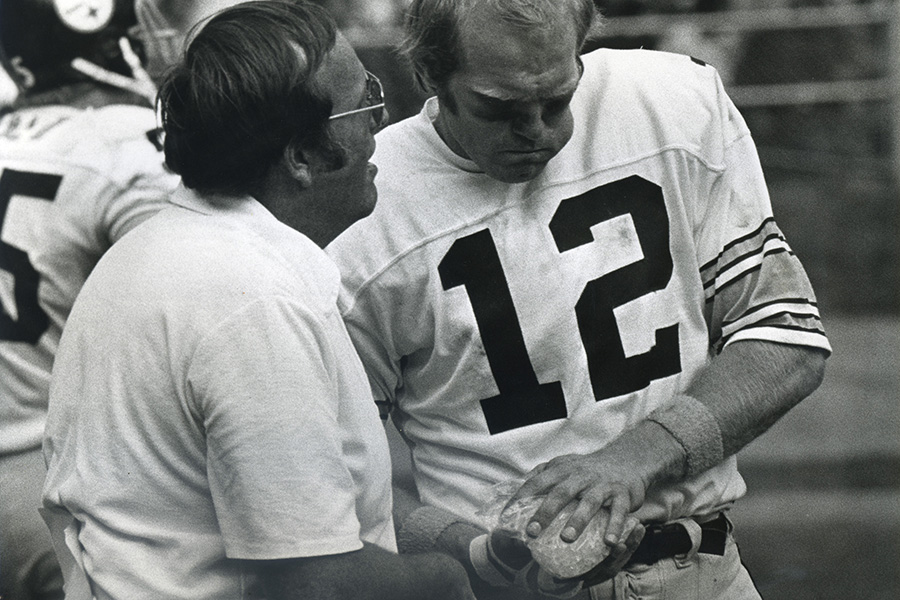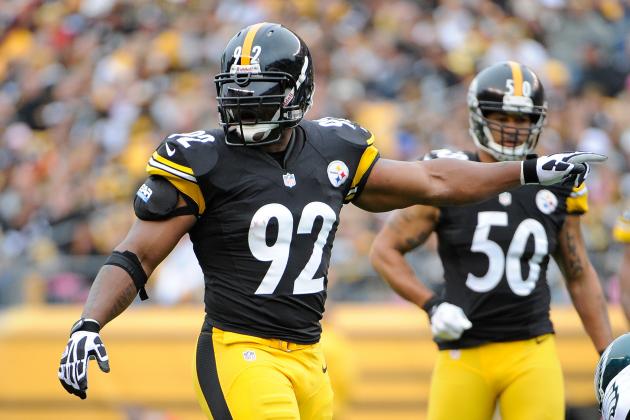
Article reposted from Steelers.com
Author: Bob Labriola
His nickname was “Plumber,” according to Rocky Bleier, “because he just had to take care of everybody – bandage them, put them back together, fix them up to get them back on the field,” but during his 24 years with the Pittsburgh Steelers, Ralph Berlin was much more than the trainer. He was part of their personality.
Mr. Berlin died on Tuesday, Aug. 2. He was 81. Beloved husband of 56 years to Dolores “Dee” Berlin; loving father of Elizabeth (Michael) Toth and Steven (Kerri) Berlin; devoted grandfather “Pa” of Genna (Jimmy), Sarah (Mark), Michael, Devin, Chelsi (Michael), Clay, Chase and Megan. Ralph served as a sergeant in the USMC. He received his Bachelor of Science in Physical Education from Iowa State University and his Master of Science in Health and Safety from Indiana University.
After serving with the U.S. Marine Corps, Mr. Berlin came to be a trainer at the University of Kentucky, and that’s where he met Art Rooney Jr. It was during the 1960s when NFL scouting was not nearly as sophisticated as it is today, but even back then it was wise for an NFL scout to talk to the trainer while on campus. When the Steelers job opened, Art Rooney Jr. helped set up an interview for Mr. Berlin with his brother, Dan Rooney. Mr. Berlin got the job, and in 1968 he had fulfilled his dream of becoming a trainer for an NFL team.
Having been hired in 1968, Mr. Berlin already was there when Chuck Noll became the team’s coach in January 1969, and thus had a front-row seat to the transformation of the Steelers from lovable losers to one of the most dominant dynasties in NFL history.
There were a lot of Hall of Fame players on those Steelers teams during the 1970s, and many who aren’t Hall of Fame players still were stars. As a result, camaraderie was important, and while Coach Chuck Noll deserves the credit for instilling the singleness of purpose that was the backbone for all that winning, others helped with morale, and Mr. Berlin was always up for that.
“Ralph came to the Steelers right before I got there in 1968, and we went through the whole growth, progress, and success of the Steelers together,” said Rocky Bleier. “Ralph was a unique person. He was a part of the personality of the team, a part of the structure of the team. He kept the locker room loose. He had a great rapport with the players. You could joke with him. He always had a cigar in his mouth, and that was all through training camp as well as during the season. He will be sorely missed.”
Indeed, players could joke with Mr. Berlin, but they also knew such playfulness never was going to be a one-way street.
“Ralph was the most lovable buster of chops I ever met,” said Tunch Ilkin. “He would be busting your chops from the moment you walked into the training room until the moment you left, but it was in a fun way. He was just a lot of fun. He was just really, really caring. The training room was a very lively place with Ralph. I’ll always have an image in my mind of Ralph with that cigar in his mouth, taping ankles, and busting our chops.”
Frenchy Fuqua had come to the Steelers from the New York Giants, and in the 1970 regular season finale he set a franchise record by rushing for 218 yards against the Philadelphia Eagles. As that day began, Fuqua was experiencing back spasms and some doctors advised him not to play, but he wanted to give it a try even though the Steelers were out of playoff contention. Fuqua remembered, “They put this hot stuff on my back and wrapped me up. I went through the pregame workouts and kept moving because I couldn’t let it stiffen up on me. On the first play of the game, I went for a long touchdown – 72 yards – and my back didn’t hurt. I came to the sideline, and Ralph said, ‘I’m a great trainer, aren’t I?’ I had to laugh.”
Another bit of Steelers history in which Mr. Berlin played an active role, was the annual Thanksgiving turkey prank pulled on the rookies. It started with a list posted before Thanksgiving in the training room advising rookies to sign up for a free turkey.
As Mr. Berlin told the story to Pittsburgh Sports Daily, “There were no turkeys of course. Once, Mel Blount told Tony Dungy that he wanted to have Tony bring his turkey to his house where Mel’s wife would cook it along with a ham for Thanksgiving dinner. I told Tony to talk to Jim Boston, the business manager, about how to pick up his turkey. Jim said he saw Tony’s turkey, but since he didn’t know whose it was, he gave it to Dan Rooney. So Tony went to Dan’s office and said that Jim Boston said he gave Dan his turkey. Dan kept up the joke and told Tony that since he didn’t know who the turkey belonged to he had given it to Chuck Noll. Well, Tony wasn’t going to go into Chuck’s office and ask for his turkey. So Tony goes back to Mel and says he doesn’t know what to do now. Everyone in the locker room broke up laughing.”
A prankster and chops-buster for sure, but the Steelers players who knew him also understood Mr. Berlin was there for them whenever and for whatever they might need.
“Once I woke up in the middle of the night with heart palpitations, and I started to panic,” remembered Ilkin. “I called Ralph, and he was calming, and then he started walking me back through my day. Eventually, he asked me if I had been eating a lot of chocolate, and I confessed to that. Then he asked me if I had been drinking a lot of coffee, and I told him I was drinking the coffee while I was eating the chocolate. He laughed a bit then, and told me to relax, that I wasn’t having a heart attack. I was just over-caffeinated. The next day I was fine. He was right.”
Even after retiring from the Steelers, Mr. Berlin still made himself available to help both the team and the other athletic trainers within the NFL. He annually attended the NFL Scouting Combine, where physicals and medical reports have to be done on 300-some college players over the course of a single week. His helpfulness and good humor made him a mentor for many young men and women in the profession.
He was a longtime active member of Ruthfred Lutheran Church. Friends will be received on Thursday from 6-8 p.m. and Friday from 2-4 and 6-8 p.m. at Paul L. Henney Memorial Chapel, 5570 Library Rd., Bethel Park. Funeral service will be held on Saturday, 11 a.m., at Ruthfred Lutheran Church. A private interment service will be held on Monday in the National Cemetery of the Alleghenies. The family requests any memorial donations may be made in his name to Ruthfred Lutheran Church, 3401 South Park Rd., Bethel Park, PA 15102.
“Ralph was unique in every sense of the word,” said Jerry Olsavsky. “A great man. He had your best interest in mind all the time, even if you didn’t know it. He was a great Steeler. Every guy he helped through something rough, you generally left smiling even if he took you down a notch or two along the way. You don’t just don’t come across people like Ralph Berlin anymore.”


